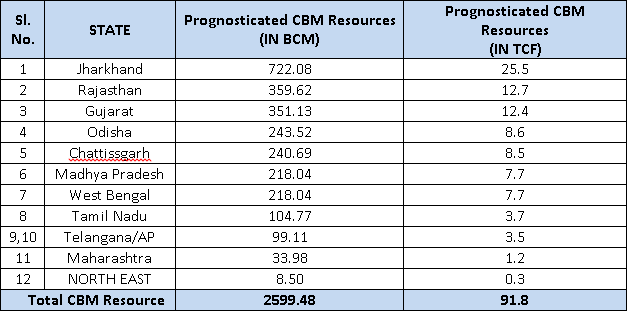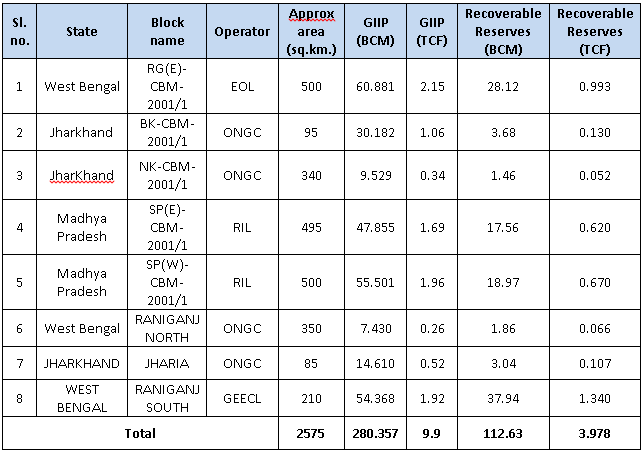Coal Bed Methane (CBM)
Coalbed Methane (CBM), an unconventional source of natural gas is now considered as an alternative source for augmenting India’s energy resource. India has the fifth largest proven coal reserves in the world and thus holds significant prospects for exploration and exploitation of CBM. The prognosticated CBM resources in the country are about 92 TCF (2600 BCM) in 12 states of India. In order to harness CBM potential in the country, the Government of India formulated CBM policy in 1997 wherein CBM being Natural Gas is explored and exploited under the provisions of OIL Fields (Regulation & Development) Act 1948 (ORD Act 1948) and Petroleum & Natural Gas Rules 1959 (P&NG Rules 1959) administered by Ministry of Petroleum & Natural Gas (MOP&NG).
CBM blocks were carved out by DGH in close interaction with Ministry of Coal (MoC) & Central Mine Planning and Design Institute (CMPDI), Ranchi. Under the CBM policy, till date, four rounds of CBM bidding rounds have been implemented by MOP&NG, resulting in award of 33 CBM blocks [including 2 blocks on Nomination and 1 block through Foreign Investment Promotion Board (FIPB) route] which covers 16,613 sq. km out of the total available coal bearing areas for CBM exploration of 26,000 sq. km. To date, most CBM exploration and production activities in India is pursued by domestic Indian companies. Total prognosticated CBM resource for awarded 33 CBM blocks, is about 62.4 TCF (1767 BCM), of which, so far, 9.9 TCF (280.34 BCM) has been established as Gas in Place (GIP).
The Gondwana sediments of eastern India host the bulk of India’s coal reserves and all the current CBM producing blocks. The vast majority of the best prospective areas for CBM development are in eastern India, situated in Damodar Koel valley and Son valley. CBM projects exist in Raniganj South, Raniganj East and Raniganj North areas in the Raniganj coalfield, the Parbatpur block in Jharia coalfield and the East and west Bokaro coalfields. Son valley includes the Sonhat North and Sohagpur East and West blocks. Currently, commercial production has commenced from Raniganj South CBM block operated by M/s. GEECL since July 2007.
Current CBM production (March 2015) is around 0.77 MMSCMD from 5 CBM blocks which includes test gas production from 4 CBM blocks and commercial production from 1 CBM block. Seven more CBM blocks are expected to start commercial production in near future. The total CBM production is expected to be around 4 MMSCMD by end of 12th plan as per XII plan document.
State-wise distribution of CBM Resources in India

Conversion factor: 1 cubic meter = 35.3147 cubic feet
BCM: Billion Cubic Meter; TCF: Trillion Cubic Feet
The data is generated as a Joint Exercise by DGH and Retd. Shri ND Mitra, Dy. DG (GSI) based on Coal Resource data.
In Place CBM Resources

Activities and Status note of COD-Shale Gas as on 01.04.2015
Combay Basin:
- Five exclusive shale gas and oil locations were released in the year 2014-15
- Proposal for submission of more exclusive locations in Broach Depression are at the final stage.
- Drilling of exclusive shale gas well GNSGA (Gandhar Ext-II) in Gandhar area completed, carried out shale gas specific log studies of Combay shale section.
- Drilling of two dual objective wells GGAH (Gandhar Ext. VI) & KLXF (kadi ML) has been completed and cores have been collected
- Two locations (GNSGB (Gandhar Ext.I) & GNSGC (Gandhar Ext.III) in Gandhar area of Combay basin are under drilling.
- LAQ and Site preparation for released locations are in progress.
- Laboratory studies of Combay shale for exclusive shale gas/ oil well (IMSGA) and other dual objective wells (SKBH, GGAF & GGAH) are completed.
KG Basin:
- Source rock logging & evaluation Study and field and Laboratory investigation study for Raghavapuram Shale (HG-HR) were completed on core samples of Wells MSAC and SUWAA in Malleswaram Block.
- Two Exclusive shale gas/oil locations WGSGA in West Godavari Block and MASGA in Mahadevpatanam Block were released and are under Land acquisition.
- Proposal for submission of third exclusive location MD-SG-1 in Mandapeta Block is in final stage.
- One conventional well WPGAA in Godavari Block is under drilling, Extensive coring and Laboratory studies and shale gas specific logging are planned.
- Drill sites for three conventional wells NGSAA in West Godavari Block, GMTAA in Kavitam Additional Area Block and SPM-AA in South Penumadam Area in Godavari Block are completed.
Cauvery Basin:
- Two exclusive locations for shale gas/oil assessment, KUSGA in Kuthalam ML and TKDSGA in L-I PML were released.
- A dual objective well PDAB in the L-II block was drilled. Two conventional cores were cut in the well for Shale Gas assessment.
- Special logs like NGS, DSI and ECS were recorded in the target formation Andimadam.
- Lab studies of the cores & cutting of well PDAB, such as sedimentological, biostratigraphic , petrophysical and source rock studies were carried out.
- The desorption studies of the two cores of well PDAB as well as the two cores cut in the well ASAE (drilled in 2013-14) were completed.
Assam & Assam Arakan Basin:
- Lab studies were carried out for evaluation of shale gas / oil potential of Kopili formation on core sample collected in two conventional exploratory wells: # Geleki-373 (GKBO) in Namti PML block and # Lakwa-578 (LDG) in Lakwa PML block.
STATUS OF GAS HYDATE EXPLORATION IN INDIA (31.03.2015)
- Gas hydrate is a crystalline solid, its building blocks consist of a gas molecule surrounded by a cage of water molecules. Each molecule of Gas hydrate contains upto 164 m3 of Methane (CH4). Initial work in India on Gas Hydrates as energy resource, was done by GAIL and NIO. In 1995 an expert committee realized the potential of gas hydrates in India.
- Gas hydrate exploratory activities/ research in India is being steered by the Ministry of Petroleum & Natural Gas under National Gas Hydrate Program (NGHP) which was initiated in 1997 with participation from Directorate General of Hydrocarbons (DGH), National E&P companies (Oil and Natural Gas corporation Ltd, GAIL India Ltd, Indian Oil Corporation & Oil India Ltd) and National Research Institution (National Institute of Oceanography, National Geophysical Research Institute and National Institute of Ocean Technology). Steering Committee is headed by Secretary, P&NG with Joint Secretary (E) as convener. The Technical Committee is chaired by DG, DGH and has participation from all National Oil Companies (NOC) like OIL, ONGC, GAIL, IOCL, and National Institutes like the NGRI, NIO & NIOT. The NGHP was restructured in the year 2000.
- To meet the challenges of exploring gas hydrate, which is at a research stage the world over, MoPNG / DGH have signed MoU with various agencies for sharing of knowledge and scientific data:
- MoU with USGS,
- MoU with US-DOE (under renewal),
- MoU with US-MMS (now called US-BOEM, under renewal)
- MoU with JOGMEC, Japan
- MoU with GFZ-POTSDAM, Germany
- MoU with IFM-GEOMAR, Germany
Current Status
- NGHP carried out the expedition-01 in 2006. The presence of significant quantities of Gas Hydrate has been established in the KG, Mahanadi and Andaman basins.
- NGHP Expedition 02 aims at identifying sites which would ideally have:
- Sand dominated gas hydrate occurrence
- Reasonably compacted sediments
- Occurrence of free gas below the gas hydrate stability zone
- NGHP Expedition-02 has been approved by the Steering Committee of NGHP. NGHP Expedition 02 consists of LWD (Logging while drilling), Coring and wire line lo9gging programme at about 20 sites (40wells) in the deep water KG & Mahanadi basins. The cost of NGHP Exoedtion-02 shall be shared by OIDB (50%), ONGC (20%), OIL (10%), GAIL (10%) and IOCL (10%).
- The drill ship CHIKYU has commenced operations under the NGHP Exp-02 on the 4th of March 2015. Till the 31st march 2015 Logging While Drilling (LWD) has been completed at 13 wells. The NGHP Expediton-02, including the coring leg, is expected to be completed by the 31st july 2015.
- Expedition 03 aims at carrying out pilot production testing of at least one site in the Indian deep-water environment. However, the execution of Expedition-03 depends on the success of NGHP Expedition-02.